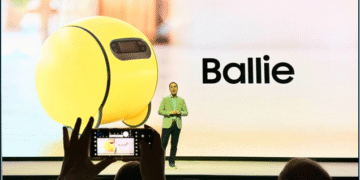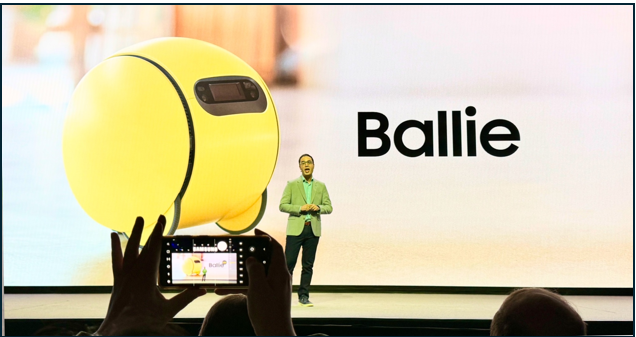Meet Samsung Ballie (2025), the AI-powered home robot that rolls, projects, and interacts with your environment. Discover how this cheerful companion blends AI, home control, and personality into one smart little sphere.
A Small Ball with Big Personality
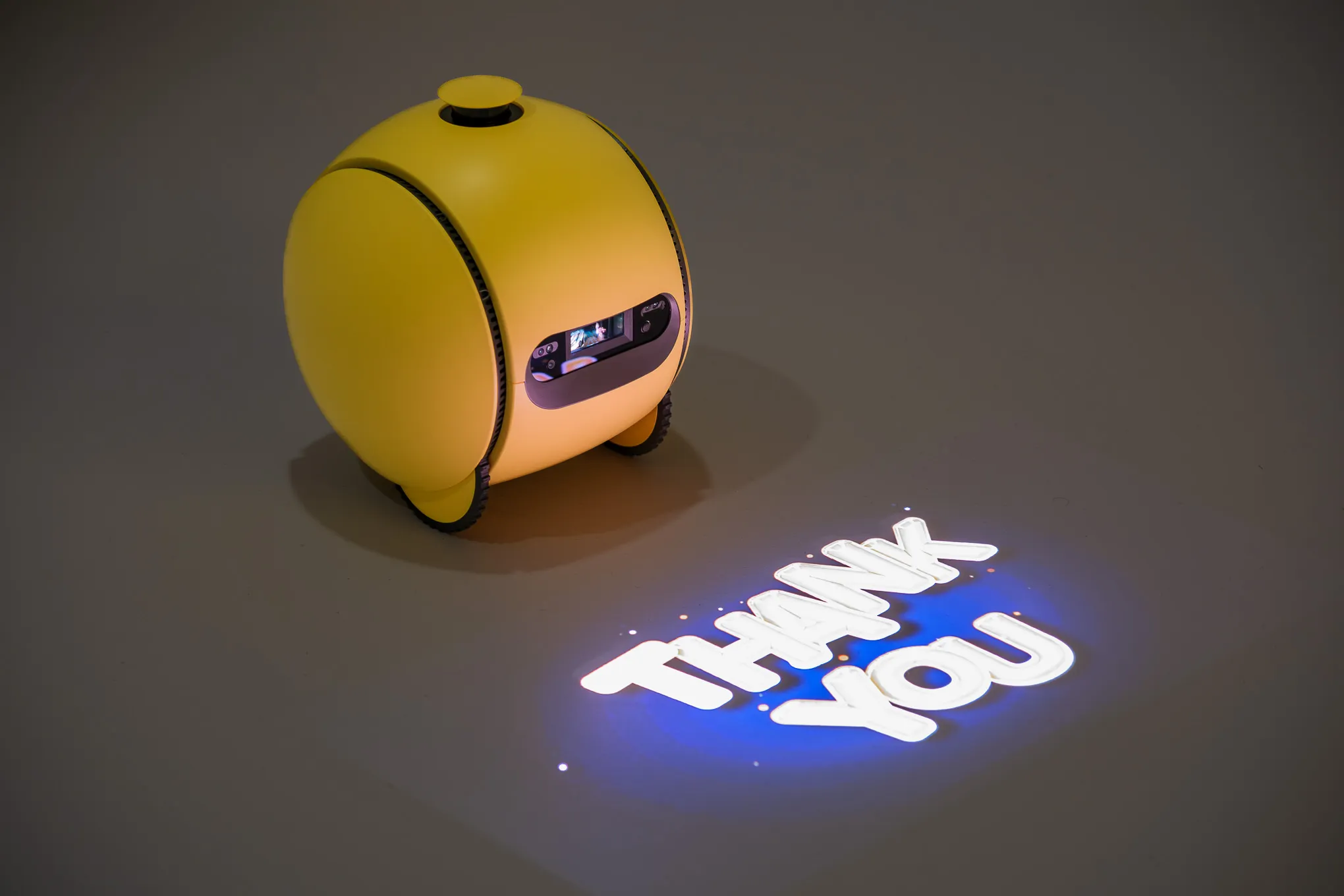
Imagine walking into your home and being greeted by a glowing little sphere that rolls toward you, projects your messages onto the wall, and says, “Welcome home, I’ve adjusted the lights and brewed your coffee.” That’s the Samsung Ballie (2025) — part personal assistant, part AI pet, and part smart-home controller.
First introduced as a prototype in 2020, Ballie’s new 2025 edition isn’t just a concept anymore. It’s now a fully functional, AI-powered companion designed to integrate with your smart home ecosystem. Think of it as your mobile Alexa with a projector and a personality.
Rolling Through Daily Life
In real homes, Ballie works like a tireless assistant. It patrols rooms to monitor conditions, checks air quality, and even projects videos, workouts, or family photos onto walls or floors using its built-in HD projector.
If it detects you waking up, it can trigger your morning routine — lights on, curtains open, thermostat adjusted — all based on learned patterns. When you leave the house, Ballie automatically patrols, notifying you of unexpected movement or door openings.
Pet owners especially love it. Ballie’s AI recognizes pets and can toss treats, play videos, or track activity while owners are away. It even sends short updates like, “Buddy has been sleeping for three hours. Would you like to play a video?”
Ballie’s mobility means it doesn’t just listen — it moves with purpose. You can command it via voice, smartphone, or Samsung’s SmartThings app.
How It Works: Smarts in Motion
At the heart of Ballie is a powerful AI vision system that maps your home and tracks objects, pets, and people. The 2025 version introduces improved SLAM navigation (Simultaneous Localization and Mapping), meaning it glides around furniture smoothly and remembers your floor plan better than earlier versions.
The built-in HD projector supports visual feedback — projecting movie clips, calendars, or even your video calls directly onto a wall. It’s not as bright as a standalone projector, but it’s surprisingly sharp in dim settings.
Ballie integrates with SmartThings, Samsung TVs, and other IoT devices, letting it act as a mobile control hub. You can tell it to “turn off the kitchen lights,” and it will roll there, confirm the command visually, and do it.
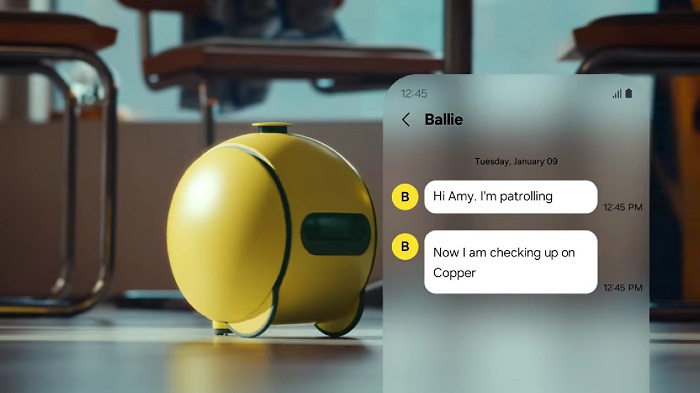
This combination of AI personality and motion makes Ballie less of a gadget and more of a character — it chirps, spins, and expresses mood through lights and tone, almost like a digital pet with manners.
The Good Stuff
There’s a lot to love about Ballie’s mix of charm and utility. The mobility gives it a presence no stationary device can match. Its AI integration makes it an adaptable companion — scheduling, projecting, reminding, entertaining, and monitoring all in one.
The projector feature is a true highlight, transforming empty walls into temporary displays for notes, movies, or video calls. For small apartments or smart homes, this multi-functionality adds immense value.
Privacy-conscious users will appreciate that most AI processing happens on-device, not constantly in the cloud. Samsung’s emphasis on local AI means your voice commands and video feeds aren’t automatically uploaded to external servers.
Perhaps Ballie’s biggest win, though, is emotional. It feels alive. Watching it spin around, greet you, and project little emojis makes interacting with AI oddly human again.
The Not-So-Great Parts
No product is perfect, and Ballie still has room to roll forward.
The battery life lasts about two hours on heavy use or six hours in standby mode, meaning it needs frequent trips back to its dock. Its mobility also depends on smooth flooring — rugs, thresholds, or uneven surfaces can occasionally trip it up.
The projector, while fun, lacks high brightness in sunny rooms. And while its AI assistant is improving, it’s still not as deep as Alexa or Google Assistant in complex task handling.
At roughly $1,299, Ballie sits in premium territory, especially for something that’s more personality-driven than essential. Some users may view it as an expensive novelty until Samsung expands its app ecosystem.
Pros and Cons
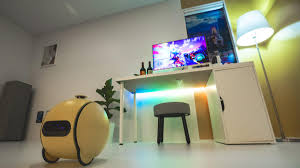
Pros:
- Mobile AI assistant with on-device learning and SmartThings integration
- Built-in HD projector for media and smart feedback
- Pet monitoring and interaction capabilities
- Local AI processing for better privacy
- Personality and design that feel genuinely friendly
Cons:
- High price point for early adopters
- Short battery life during active use
- Limited projector brightness
- Occasionally stumbles on uneven floors
- Still building third-party support
Who It’s For
Samsung Ballie 2025 isn’t meant for everyone. It’s perfect for tech-savvy homeowners, early adopters, and families who already live in a smart home ecosystem. For pet owners or people who spend long hours away from home, Ballie adds companionship and control rolled into one.
It’s less about replacing assistants like Alexa or Siri, and more about adding mobility and character to your connected environment. Think of it as a roaming smart-home butler that knows when to be quiet and when to say hello.
Quick Verdict & Star Ratings
| Category | Rating | Notes |
| Design & Personality | ★★★★★ | Adorable, sleek, and full of charm. |
| AI & Navigation | ★★★★☆ | Smooth mapping; could use more integrations. |
| Features & Utility | ★★★★☆ | Projector and pet monitoring are standout. |
| Battery & Mobility | ★★★☆ | Needs frequent docking; prefers flat floors. |
| Value | ★★★★☆ | Expensive, but delightful for smart-home lovers. |
Final Thoughts
The Samsung Ballie 2025 is what happens when smart-home technology grows a heart. It doesn’t just respond to commands—it cares enough to move toward them. Whether it’s playing with your pets, projecting your next meeting on the wall, or checking if you locked the door, Ballie’s combination of intelligence and warmth makes it one of the most lovable pieces of AI hardware on the market today.
It’s not perfect yet, but it’s proof that the future of AI in our homes isn’t just about convenience—it’s about connection.
